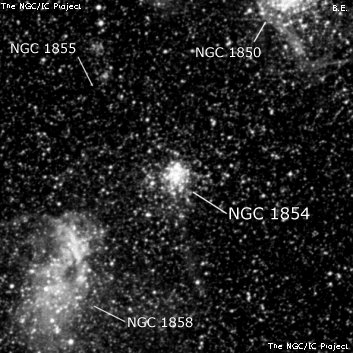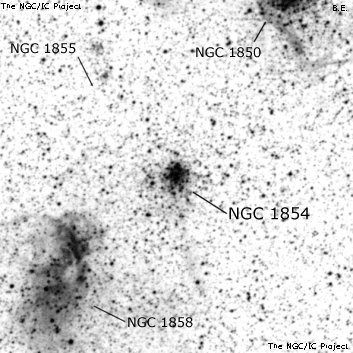NGC/IC Project Restoration Effort
(This is a very very beta version)
NGC1854


Basic Information
Location and Magnitude
Right Ascension: 5:9:20.0
Declination: -68:50:51
Constellation: DOR
Visual Magnitude: 10.4
Historic Information
Discoverer: Dunlop
Year of discovery: 1826
Discovery aperture: 9.0
Observational
Summary description: globular, cB, S, R, gbM, 2nd of 3
Sub-type: GCL
Corwin's Notes
=====
NGC 1854 and NGC 1855 are the "core" and "halo," respectively, of a stellar
association in LMC. JH picked up NGC 1854 in five different sweeps, but only
noticed NGC 1855 in one -- looking at DSS1, I can see why he recorded the
the objects this way. The "core" is a much more prominent object than the
"halo."
When I first looked at this, I made the center of NGC 1855 slightly preceding
NGC 1854 and added, "JH obviously has them reversed." Looking at them now
(November 2013) on the DSS2R, I would judge JH closer to the "truth" of the
positions than I was. I've adjusted the position of NGC 1855 accordingly.
(Sorry about that!)
Brent Archinal was, as far as I know, the first to point out the core/halo
structure of the object(s) in "Star Clusters."
Steve's Notes
=====
NGC 1854
24" (4/7/08 - Magellan Observatory, Australia): I revisited this remarkable field after viewing NGC 1850 (located 6' NW) the previous night. At 200x this cluster appeared very bright, large, round, with a brilliant core. At 350x, it was resolved into numerous faint stars around the edges of the intense core. Up to a couple of dozen very faint stars popped in and out of visibility. The core is noticeably elongated N-S and is surrounded by a large, much fainter halo. There is a small clump of stars at the NW edge. NGC 1858, a large star cluster and nebulosity, lies 4' SE.
18" (7/10/05 - Magellan Observatory, Australia): fairly bright, fairly small, oval 4:3 NW-SE, 0.8'x0.6', moderate concentration. There is a small knot attached to the north edge. Located 6' SE of NGC 1850 with NGC 1858 4.5' further SE in a region of the LMC packed with clusters.



